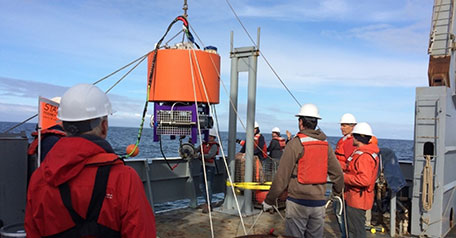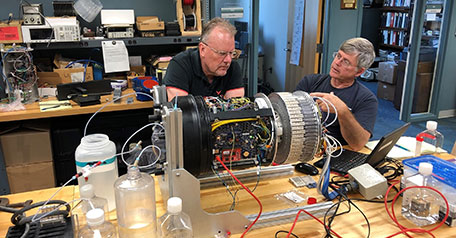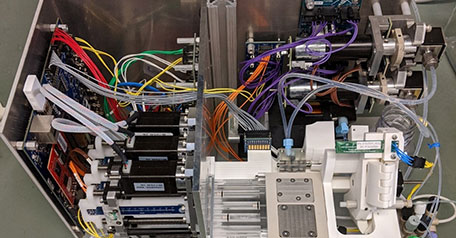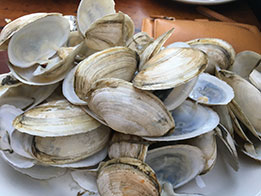Toxin Detection Technologies
NCCOS uses three detection strategies to accurately measure algal toxins despite the unique challenges. Our scientists develop biochemical methods largely for sensor applications. We develop and validate chemical methods notably tandem mass spectrometry to identify and measure specific congeners, especially in complex matrices. Additionally, we develop and validate biological methods to provide sensitivity for a toxicity measure of mixtures of toxins.
Measuring and Assessing HAB Toxins
Confirmation of algal toxins has historically been elusive due to the complexity of toxin composition and challenges to quantifying the very low levels of toxins that can be lethal to marine wildlife. Managers of coastal resources need accurate information and need it in time to make informed decisions involving shellfish harvest, life support for marine wildlife, beach closures, and remedial actions. NCCOS uses a two-tiered approach combining the power of bioassay screening with sensitive analytical methods to measure HAB toxins across a wide range of sample types with unambiguous detection at low levels. These data inform coastal managers about the impacts during HAB events so they can make informed decisions to reduce the impact to ecosystems and communities.
Analytical Reference Methods & Screening Bioassays
NCCOS scientists are developing and implementing detection tools to monitor HAB toxins, which is critical in mitigating their impacts. Diagnostic methods allow for the monitoring of coastal resources to provide an early warning of potential HAB impacts that could affect human health. This work is also crucial for use in further understanding the impacts HAB toxins may have on ecosystems.
Toxin Sensors for Uncrewed Systems
The recently reauthorized Harmful Algal Bloom and Hypoxia Research and Control Act legislation directs NOAA to develop and enhance its use of uncrewed systems to observe and monitor harmful algal bloom (HAB) events. Under this mandate, NCCOS is vigorously pursuing the development of HAB toxin sensors for deployment on autonomous, mobile and fixed-position, and robotic platforms in marine and freshwater systems. These platforms include the second and third generation (2G and 3G) Environmental Sample Processor (ESP). The ESP, or “lab-in-a-can,” is integrated with either a stationary mooring/lander system (2G ESP) or a long-range autonomous underwater vehicle (3G ESP), respectively, to provide command/control and telecommunication capabilities. Sensors custom-designed for use on these uncrewed systems target toxin classes occurring in marine (domoic acid, saxitoxins) and freshwater (microcystins) environments, and numerous deployments have spanned the coasts of central and southern California, Washington State, the Gulf of Maine, and western Lake Erie. Dissemination of data generated by these ESPs are generally coordinated through the appropriate IOOS Regional Association, taking advantage of their existing regional stakeholder networks.
Chemical Instrumental Methods and Bioassays for Toxin Analysis
Liquid chromatography coupled to tandem mass spectrometry (LC-MS/MS) is a universal tool for analysis of both marine and freshwater biotoxins. Bioassays, including radioimmunoassays, enzyme-linked immunoassays, receptor-binding assays, and cytotoxicity assays, are routinely performed in our lab to give estimates of total toxin levels by toxin groups. Bioassays are also used in screening applications to provide clues for further instrumental identification of toxins and their metabolites or derivatives.
Our Partnerships
NCCOS research on HABs integrates and leverages contributions and technologies from multiple partners in order to maximize the return on its investment and strategically address the needs of its customers. These mutually beneficial partnerships span Federal and state agencies, NGOs, academia, industry and community science groups, and yield information products, tools, and technologies that are targeted and highly responsive to stakeholder priorities.

Monterey Bay Aquarium Research Institute
The 25-year milestone for NCCOS’ collaboration with the Monterey Bay Aquarium Research Institute in the area of HAB sensor development was recognized in 2021 and has yielded numerous advances in the deployment of autonomous sensors for HAB species and toxins.
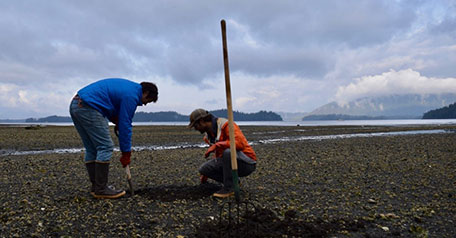
Southeast Alaska Tribal Ocean Research (SEATOR)
A longstanding relationship between NCCOS and SEATOR led to the establishment of a regional shellfish toxin testing laboratory serving over 16 Southeast Alaska tribes, providing timely information on levels of life- threatening paralytic shellfish toxins in subsistence harvested shellfish, along with dissemination of harvesting advisories.

